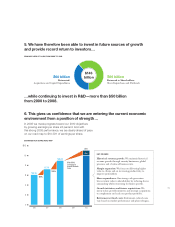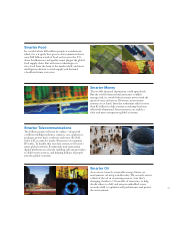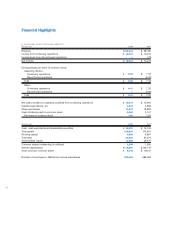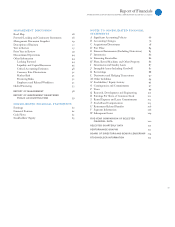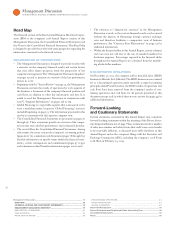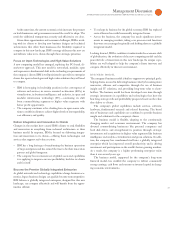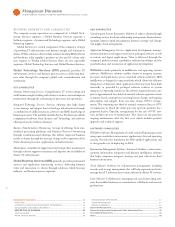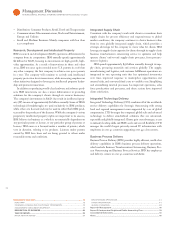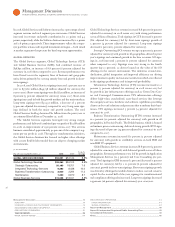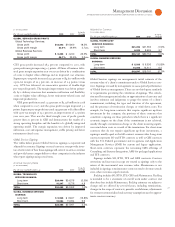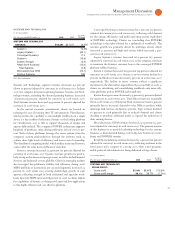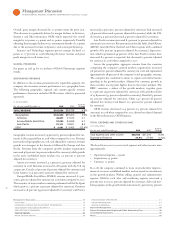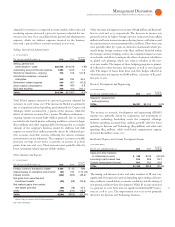IBM 2008 Annual Report Download - page 25
Download and view the complete annual report
Please find page 25 of the 2008 IBM annual report below. You can navigate through the pages in the report by either clicking on the pages listed below, or by using the keyword search tool below to find specific information within the annual report.
Management Discussion
INTERNATIONAL BUSINESS MACHINES CORPORATION and Subsidiary Companies
Rational
Software
. Software tools that help clients manage their soft-
ware development processes and capabilities. With the acquisition of
Telelogic in , Rational software supports software development
for both IT solutions and embedded system solutions.
Operating Systems. Software that manages the fundamental processes
that make computers run.
Systems and Technology provides clients with business solu-
tions requiring advanced computing power and storage capabilities.
Approximately percent of Systems and Technology’s server and
storage sales transactions are through the company’s business partners;
approximately percent are direct to end-user clients. In addition,
Systems and Technology provides leading semiconductor technol-
ogy and products, packaging solutions and engineering technology
services to clients and for IBM’s own advanced technology needs.
SYSTEMS AND TECHNOLOGY CAPABILITIES
Servers. IBM systems, which are typically connected to a network and
provide the required infrastructure for business. These systems use
both IBM and non-IBM operating systems, and all IBM servers can
also run Linux, a key open source operating system. (System z, legacy
System i, converged System p and System x).
Storage. Information infrastructure products and solutions, which
address critical client requirements for information retention and
archiving, availability and virtualization, and security and compli-
ance. The portfolio consists of a broad range of disk and tape storage
systems and software.
Microelectronics. Semiconductor design and manufacturing primarily
for use in IBM systems and for sale to external clients (OEM).
Retail Store Solutions. Point-of-sale retail systems (network connected
cash registers) as well as solutions which connect them to other store
systems.
Global Financing is described on pages through .
GLOBAL FINANCING CAPABILITIES
Client Financing. Lease and loan financing to end users and internal
clients for terms generally between two and seven years.
Commercial Financing. Short-term inventory and accounts receivable
financing to dealers and remarketers of IT products.
Remarketing. The sale and lease of used equipment (primarily sourced
from the conclusion of lease transactions) to new or existing clients.
The following worldwide organizations play key roles in IBM’s deliv-
ery of value to its clients:
• Sales and Distribution
• Research, Development and Intellectual Property
• Integrated Supply Chain
• Integrated Technology Delivery
• Business Process Delivery
Sales and Distribution
IBM has a significant global presence, operating in over coun-
tries, with an increasingly broad-based geographic distribution of
revenue. The company’s Sales and Distribution organization manages
a strong global footprint, with dedicated country-based operating
units focused on delivering client value. Within these units, client
relationship professionals work with integrated teams of consultants,
product specialists and delivery fulfillment teams to improve clients’
business performance. These teams deliver value by understanding
the clients’ business and needs, and then bring together capabilities
from across IBM and an extensive network of Business Partners to
develop and implement solutions.
By combining global expertise with local experience, IBM’s geo-
graphic structure enables dedicated management focus for local
clients, speed in addressing new market opportunities and timely
investments in emerging opportunities. The geographic units align
industry-skilled resources to serve clients’ agendas. IBM extends
capabilities to mid-market client segments by leveraging industry
skills with marketing, ibm.com and local Business Partner resources.
In , the company implemented a new growth markets orga-
nization to increase its focus on the emerging markets of Brazil,
Russia, India and China and the additional opportunities around the
world that have market growth rates greater than the global average
— countries within Southeast Asia, Eastern Europe, the Middle East
and Latin America. The company’s major markets include the United
States, Canada, the U.K., France, Germany, Italy, Japan, Denmark,
Sweden, Switzerland, Austria, Belgium, Finland, Greece, Ireland, the
Netherlands, Portugal, Cyprus, Norway, Israel, Spain, the Bahamas
and the Caribbean region.
The majority of IBM’s revenue, excluding the company’s origi-
nal equipment manufacturer (OEM) technology business, occurs in
industries that are broadly grouped into six sectors:
• Financial Services: Banking, Financial Markets, Insurance
• Public: Education, Government, Healthcare, Life Sciences
• Industrial: Aerospace and Defense, Automotive, Chemical and
Petroleum, Electronics


